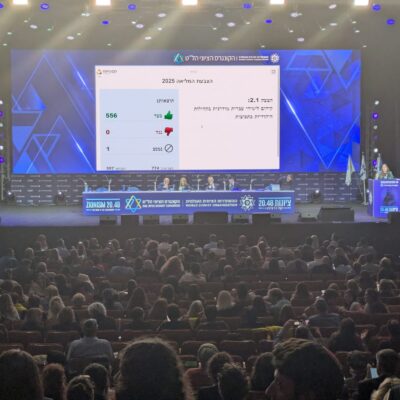Opinion
How an Employee Engagement Survey Can Actually Improve Employee Engagement

By Mimi Kravetz
When I joined Hillel International two years ago as our Chief Talent Officer with the mandate to make Hillel a premier workplace that attracted, trained and retained top talent, launching an employee engagement survey was at the top of my priority list. The goal was to benchmark where we were, direct our initiatives and investments, and track the progress the organization makes over time.
I was thrilled to learn about Leading Edge’s plans to start a sector-wide survey, and Hillel immediately took the opportunity to participate in the pilot, as well as this year’s Second Annual Employee Engagement Survey, with roughly 80 percent of Hillel’s global movement participating.
What we have learned has done more than just educate us on what our staff is thinking; the feedback has informed our future plans for talent investment, and the sector-wide data has the potential to drive positive investment throughout the Jewish world.
With that in mind, here are some thoughts on what it takes to use an employee engagement survey to actually improve employee engagement:
Trust the results. Smart people often ask critical questions of any data, looking for flaws in the analysis or hidden truths. Sometimes this is a defense to try to make sense of uncomfortable or undesirable information. Instead, assume these results, which come from significant experience across sectors, are reliable and valid enough that you can use them to act.
Socialize the insights. Start by sharing the information transparently with leaders and ensure they re-share and contextualize it with their teams. Especially for a survey intending to positively impact culture, this openness is key to building trust and gaining ongoing participation. Be sure to share the good as well as the areas for improvement, so people can feel positive about the baseline of strengths even as they engage in plans for improvement.
Designate an owner to act. Things only get done when there’s someone responsible. Decide who will own actions on the survey results. This could be a director, central leadership team, HR department, or team lead. Just know who’s accountable and make sure others know.
Fill in color. Data always raises follow up questions. Dig deeper where you have genuine curiosity that can help inform actions. You can do this through individual or group conversations.
Focus. It’s not easy to move organizations so it’s critical to select just a few elements you want to improve and make a clear plan to affect those metrics. It may require a few different initiatives to affect one metric. For example, where people feel overworked, you might add staff, create more organizational focus, and improve systems for individual goal setting. These together can help impact that single data point.
Create and share a practical plan. A clear execution plan will ensure there’s a set of concrete steps you’ll take to impact the metrics. Keep in mind this plan will likely consist of mostly practical activities like performance planning, goal setting, recognition and salary benchmarking that seem so obvious or mundane that they amount to basic hygiene rather than the type of innovation that often gets celebrated. These are the types of activities that are so exciting for our organizations to adopt because employing best practices in these spaces can make a huge difference.
Lastly, track and report on progress. We need to commit to taking the survey on an ongoing basis and noticing honestly how our actions impact the outcomes. Consistent tracking will create the learning and iterative process that leads to sustained improvement.
The Hillel movement has already started to see some impacts from our process, and related significant targeted Talent investments connected to our Employee Engagement survey results. For example, we committed to improving and expanding training opportunities for all local Hillel professionals to help them better perform their current roles and prepare them to advance in their careers. Within just six months of the launch of Hillel U, our comprehensive professional development program, our Employee Engagement survey showed a six percent improvement in scores in the Learning and Development area. Similarly, we saw an eight percent improvement in the Accountability and Feedback area partially thanks to introducing an intensive supervision course where we taught updated performance review tools.
In keeping with the recommendation to honestly report impacts, it’s notable that we also saw a decrease in professionals reporting they believe they’re compensated fairly, likely due to releasing a report on compensation benchmarks across Hillel and the nonprofit world, offering recommendations of new salary bands, and making available compensation increase grants that impacted a subset of professionals. We’re hopeful that by continuing transparency and support over time, this data will move back in a positive direction.
Certainly, participating in this survey has been worthwhile for the Hillel movement in the ways we hoped – directing our actions and demonstrating how they’re affecting our network of local professionals.
We’re hopeful that collecting this data as a sector will drive all of us to act so that all our organizations improve as workplaces and together we’ll build a sector that better attracts, supports and develops talented professionals who will impact the entire Jewish nonprofit world.
Mimi Kravetz is Chief Talent Officer for Hillel International.

 Add EJP on Google
Add EJP on Google









